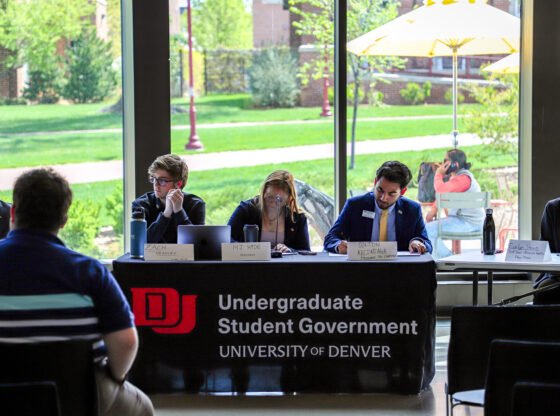With the 2020 election a mere 11 days away, voters across the country are heading to the polls (or mailbox) to cast their votes in contentious local, state and national elections. The presidential race has proven most dramatic this year, filled with its fair share of political spats over the future of our country. While last Thursday’s second and final presidential debate signaled the near ending of a restless election cycle, it did so with a calmer tone than the dramatic spats seen previously during this election. Nevertheless, this election period has seen further polarization of the news media. This has a great influence over voters and their conceptions of political reality.
Major news networks are often accused of heavy bias. In fact, scholarly research by academics like Wen-Chung Guo and Fu-Chuan Lai proves that news media select details [that] are favorable or unfavorable to the subject being described based on target audiences. Pew Research Center further explains this phenomenon—while media bias does not determine where news outlets fall on the ideological political spectrum, it highlights the audience’s political affiliations and influences reported content.
This topic is important to understand as voters head to the polls during the election cycle’s final days. Voters consume political ideologies from specific news sites, thereby widening a divide of how information is framed and what information is received. Most of this political information, however, is not derived from source context. Individuals are drawn to what catches the eye: clickbait headlines.
As the 2020 campaign winds down, The Clarion conducted a headline analysis of sources from the left, right and center over what information people were consuming after the last debate.
From the left
According to Pew, the top three most popular left-leaning news media sites are CNN, the New York Times and The Washington Post. All three organizations dedicate specific 2020 election sections to live reporting on presidential campaigns, election security and ongoing debates. Each news site also has subsections on voting information, national polls, debate fact checks, “paths to 270” and candidate positions on national issues.
The majority of articles from all three organizations pertained to the presidential debate. However, each site published niche articles regarding the debate.
Both The New York Times and The Washington Post addressed the debate’s calmer tone. In The Washington Post, articles such as “Second Trump-Biden debate has fewer interruptions but more counterpunches” spoke to the nature of the candidates’ performances. It states the headline as a fact, causing the reader to assume this is the truth rather than an argument with multiple interpretations. In contrast, The New York Times published several comprehensive analyses with argumentative headlines such as “Six Takeaways From the Final Presidential Debate” and “Who Won the Debate? Political Observers Weigh In.” This format of headline draws readers in who want to know what argumentative points they should be informed of.
Each source sporadically referenced specific issues from the debate, such as the pandemic and fracking. CNN’s headlines used statements rather than argumentative language and provided little additional context. This is seen by stories such as “New Trump campaign ad slams Biden’s position on fossil fuels and fracking” and “Biden says coronavirus vaccine ‘has to be free to everyone, whether or not you’re insured.’”
In contrast, The New York Times led articles with semi-informative headlines that drew readers in, like “Oil Industry Expresses Concern, Not Alarm, About Biden Comments.” Both styles of headlines, however, speak to liberal biases regarding party positions (in this case, on climate change and green energy).
Prior to the debate, issues of election security and finances dominated the news cycle in all three sources. The New York Times in particular put their attention towards the Trump tax return investigation. These articles portrayed the candidate as deceitful through headlines such as “In Trump Donations, Big Tax Write-Offs and Claims That Don’t Always Add Up” and “Trump Campaign Draws Rebuke for Surveilling Philadelphia Voters.”
In contrast, CNN addressed the Biden campaign’s financial situation via headlines like “Biden maintains big cash advantage in campaign’s waning days.” Both news sources support Biden’s campaign image by either highlighting his successes or illuminating the failures of his opponent. This plays to the political affiliations of their target audiences.
Interestingly, The New York Times reported on several issues of national election security, drawing reader attention to foreign interference. Headlines such as “U.S. Issues Sanctions on Russian Center Involved in Potentially Deadly Cyberattacks” and “Russians Who Pose Election Threat Have Hacked Nuclear Plants and Power Grids” invoke emotional fear within readers over election security, while alluding to Trump’s potential gain from such attacks.
In contrast, CNN played to Democratic investment in voter turnout with headlines geared toward the massive early voting campaign such as “More than 50 million Americans have cast general election ballots.” These and similar headlines returned to the incredibly popularized Democratic “get out the vote” campaign central to the party message this election cycle.
In the center
Sitting at the moderate center for news media, National Public Radio and The Wall Street Journal offer factual, straightforward analyses of the election.
In its online reporting format, NPR combines its national radio presence with in-depth political synopses to discuss the ongoing development of local, state, national and international issues. Last week’s headlines were somewhat balanced between the presidential debate and general election news.
In terms of the debate, NPR headlines presented views with takeaways for all political affiliations such as “With Debates Behind Them, Biden And Trump Enter The Final Stretch Before Election Day” and “Trump And Biden Had A Real Debate, And 5 Other Takeaways.” Rather than portraying either candidate as loser or winner in the immediate headline, the source offers a neutral yet legitimate factual understanding of what individual voters should realize after watching.
Aside from such headlines, other election news pertained to public education. These headlines included “When Will Mail-In Ballots Be Counted? See States’ Processing Timelines” and “Money Tracker: How Much Trump And Biden Have Raised In The 2020 Election.” These headlines present a neutral tone in addressing common worries regardless of political affiliation.
Furthermore, NPR spoke on the ongoing developments of foreign election interference, a pertinent issue to both sides of the political spectrum. The site published several complementary reports including “Russian Hackers Break Into 2 County Systems, Stoking Election Security Fears,” “Security Gaps Persist, Report Warns, After U.S. Blames Iran In Election Scheme” and “U.S. Blames Iran For Threatening Election Emails, Says Russia May Interfere Too.” While these headlines speak to voter concerns regarding election security, they do so in a moderate tone that refers to government-published reports.
Whereas NPR coverage encompasses a wide variety of politically relevant news, The Wall Street Journal tends to emphasize more economically-relevant political news. The majority of headlines presented the discussion of fracking in the presidential debate. The Journal specifically looked into Biden’s remarks, offering several in-depth analyses of his plan including headlines such as “Biden’s debate remarks inject energy into race.” Using “energy” both literally and figuratively, The Journal alludes to the economic impacts of Biden’s position on green energy, fracking and U.S. oil consumption.
To the right
The opposing side of the political media spectrum includes prominent conservative media sources: Fox News, The Drudge Report and Breitbart.
Throughout the week, all three conservative news sources discussed the small but significant variations in poll numbers. Breitbart specifically emphasized polling numbers in key swing states, claiming President Trump as the favorite in headlines like “Florida poll: Donald Trump 50%, Joe Biden 48%”, “Poll: Biden’s Lead in Minnesota Slips” and “Michigan Poll: Donald Trump 49%, Joe Biden 45%.”
Interestingly, Brietbart’s headlines considered polling numbers among minority voters, a unique characteristic among the three news sources. Its headlines called President Trump the favorite: “Trump approval among likely black voters jumps to 46% after debate.”
The Drudge Report expanded beyond the presidential race polls, claiming conservatives have a “96% CHANCE’ OF KEEPING HOUSE…,” with capitalization that draws attention.
One of the more contentious topics of this election season has been mail-in voting. Despite intense political battles on the topic, only The Drudge Report had related headlines such as “Battleground postal delays persist…” and “Campaign Videotaping People Depositing Ballots In Philly Drop Boxes….” These headlines were placed at the bottom of the page, signaling the consumer’s waning interest in the topic despite tactical language meant to evoke fear or anger within the reader.
The presidential debate spurred the most headline news throughout the week. Fox News and The Drudge Report highlighted Fox’s immense cable viewership with headlines like “Fox News attracts 15.4 million viewers for final Trump-Biden debate, topping broadcast, cable competitors.” This article’s popularity speaks to the politicization of news media, especially in this election cycle.
More pressing to all three sources, as indicated by headline placement, was the respective performances of each candidate. In Fox News, Biden was portrayed as “Lyin’ Biden.” This claim was supplemented by reference to a liberal news source in “CNN’s Daniel Dale offers rare fact-checks of Biden, admits Trump ‘correct’ on Dem’s anti-fracking stance.” This reference serves as an indicator of moderate political stances, or the illusion of such, to add credibility to a claim.
Breitbart similarly addressed this fact check, but in a manner that portrayed Biden as the debate’s loser: “Debate Disaster: Even CNN Busts Biden for Fracking Lie.” To complement this claim, linked articles included “Trump Classy in Final Debate,” “Biden Lies and Lies and Lies and Lies… Struggles to Complete Sentences” and “President Muted Throughout Night.” Ultimately, these headlines painted Biden’s performance as inferior and humiliating while applauding Trump as “classy,” well-prepared and the obvious winner.
Only The Drudge Report had a positive note on Biden, claiming “Post-debate polls give Joe the edge.” Reference to Biden as “Joe,” however, conveys a condescending tone since Drudge always called the incumbent “President” or “Trump.”
The most popular issue for these conservative news sites following the debate was that of Hunter Biden and the legality of his business dealings. Fox News presented the most moderate headline, but still instilled doubt in the legitimacy of the facts: “Ex-Hunter Biden partner’s records show no proof of Joe Biden business ties, but questions remain.”
Breitbart and The Drudge Report referred to the issue in headlines such as “HUNTERLEAKS” and “Inside campaign to ‘pizzagate’ Hunter…” The headlines allude to previous conservative conspiracies like “pizzagate” on suspected Democratic dealings. This language clearly pokes at polarizing political debates, legitimizing the sites’ credibility among hardline conservatives. The headline language also draws upon emotional political sentiments and compels readers to learn more in order to confirm their personal and emotional assumptions.
Ultimately, last week presented a snapshot of the continuing media bias in political news. While this analysis only discusses one week of headlining news, political bias informs our understanding of current events on a daily basis. The information you consume matters, and that is why you should know your sources.











